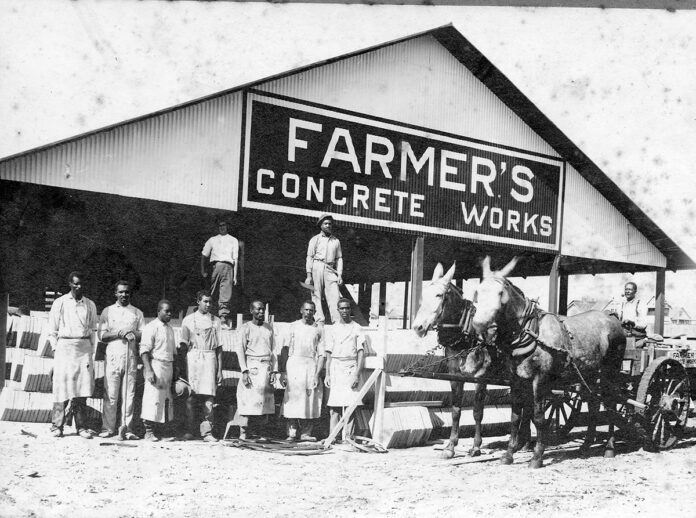If you stroll through some of St. Petersburg’s earliest neighborhoods, including the Old Southeast, Historic Old Northeast, and Historic Roser Park, then you’re sure to notice sidewalks composed of multicolored hexagon-shaped concrete. Today, those sidewalks are considered an integral part of each neighborhood’s charm, but that hasn’t always been the consensus. Luckily, after some mid-century removals, the remaining hex block sidewalks are protected “within, and adjacent to, historic districts, hexagon block preservation districts, and landmarks.” This shift recognized that the iconic hex blocks are a vital part of St. Pete’s history as well as appealing traditional streetscape features.
St. Pete Grows
The 20th century saw the city expand as developers pushed out its existing borders. Alongside that growth came rising population, as more people sought out new opportunities and a sunny clime. By 1930, St. Petersburg was home to more than 40,000 people as compared to only 1,600 early settlers at the turn of the century. In the early days of this phenomenal growth, Hope Aciel Farmer arrived for a visit. His decision to stay and seek his fortune in the booming building market ultimately helped lay the foundation for the now iconic sidewalks. Even before Farmer’s arrival, a community of Black laborers already had established itself as a crucial element of the local economy and city growth. These workers proved to be essential to the spread of hex-block sidewalks throughout the city.

African American Labor & the Growth of St. Pete
Arriving in 1868, the formerly enslaved John Donaldson and his family were instrumental in building the foundation for the community that would become present-day St. Petersburg. They were the city’s only African-American family until the 1888 construction of the Orange Belt Railway brought more than 100 additional Black laborers to town. In the decades afterward, St. Pete experienced steady growth in size and population, and Black workers provided much of the foundational labor necessary to build and maintain the community. By 1910, Black citizens made up almost 27 percent of the town’s population. Despite escalating efforts to segregate and deny them their basic rights, African Americans were vital to St. Pete’s economic success. Black workers did laundry, cleaned rooms, and carried bags for the expanding tourist trade. Black men overwhelmingly filled the lowwage jobs that built and maintained the growing city, from paving roads and digging sewer lines to collecting garbage and constructing houses, hotels, and new businesses.
Hope Farmer and the Building of St. Pete
This was the community that greeted Hope Farmer in 1905, when he arrived to take charge of building a former neighbor’s new home. As a contractor from the small northeast central Florida town of Starke, Farmer apparently recognized the potential for success as part of St. Pete’s up-and-coming building growth. His wife, Rebecca, reluctantly agreed to join him. According to family lore, she wept as she packed to leave their Starke home but fell in love with St. Petersburg once she arrived. Soon after they settled in, Farmer established his first venture: H.A. Farmer, Contractor, and Builder. He advertised alongside businesses that gave evidence of the city’s shift from a frontier village to a growing city, including competing grocery stores L.A. Kluts and Ed. T. Lewis, Sidney C. Wood Real Estate, and Harrison Bros. Fire Policy Insurance. Farmer experienced sufficient success in the building trade to be ready to take advantage of a new opportunity when he saw it. As the city moved farther from its village roots, it looked to replace its wood and shell walkways with concrete. In 1912, Farmer rebranded his company as Farmer Concrete Works and embarked on the work that would cement the Farmer name in St. Pete history: creating iconic hex-block sidewalks.
Farmer Concrete Works
Why the city chose to use the hex blocks rather than rectangular slabs has been a subject of debate for decades. Some hold that the hex blocks adapt more easily to the floating and shifting sandy Florida soil. Others maintain that because the blocks came in five different colors (gray, red, green, blue, and yellow), the choice stemmed from the desire to create colorful mosaic sidewalks rivaling those of Rio de Janeiro. Regardless, Farmer Concrete Works was a success. Operating out of the “hustling beehive” of St. Pete’s earliest industrial zone, Black laborers manufactured, hauled (initially by wagons and mules), and laid the blocks. By the 1920s building boom, Farmer Concrete had grown to 100 employees and carried the hex blocks in trucks instead of wagons. The business relocated to 24th Street S, closer to the segregated 22nd Street neighborhood where many of the company’s Black laborers lived. Unfortunately, this level of success didn’t last. In 1926, the building boom crashed, and Farmer was forced to downsize. By the 1940s, citing cost and safety concerns, the city ceased using hex blocks. A Legacy Endures Nearly 80 years later, the sidewalks are physical reminders of St. Pete’s history. During its tenure, Farmer Concrete Works and its mostly Black laborers manufactured, hauled, and laid more than 100 miles of hex block sidewalk. Many that remain are stamped “Farmer Concrete Works,” ensuring that Hope Farmer’s name lives on. His legacy is incomplete unless we also remember the many Black laborers who toiled under the hot sun and the oppression of Jim Crow laws to construct those sidewalks.
Thanks to Scott Taylor Hartzell for his prior research. Full source list available on request.



Great story. Native citizen born in 72. Love it
Thanks for reading GBM, Jim. Glad you enjoyed this article!
Yes correct that was a great story it’s good to read about the history of Saint Pete just like I read about the corner of 62nd Avenue and 4th Street North with a roundabout at Each corner pretty interesting stuff
Comments are closed.